New Insights on the Feature and Function of Tail Tubular Protein B and Tail Fiber Protein of the Lytic Bacteriophage φYeO3-12 Specific for Yersinia enterocolitica Serotype O:3
Abstract
1. Introduction
2. Materials and Methods
2.1. Gene Cloning and Protein Overexpression, Purification and Analysis
2.2. Protein Folding and Aggregation Tests
2.3. Measuring the Effect on Biofilm Formation
3. Results and Discussion
3.1. Bioinformatics Analysis
3.2. Gene Cloning and Protein Overexpression, Purification and Analysis
3.3. Protein Folding and Aggregation Tests
3.4. Influence of TTPBgp12 and TFPgp17 on Biofilm Formation
4. Conclusions
Supplementary Materials
Author Contributions
Funding
Acknowledgments
Conflicts of Interest
References
- Ackermann, H.W.; Prangishvili, D. Prokaryote viruses studied by electron microscopy. Arch. Virol. 2012, 157, 1843–1849. [Google Scholar] [CrossRef] [PubMed]
- Pajunen, M.I.; Kiljunen, S.J.; Söderholm, M.E.; Skurnik, M. Complete genomic sequence of the lytic bacteriophage phiYeO3-12 of Yersinia enterocolitica Serotype O:3. J. Bacteriol. 2001, 183, 1928–1937. [Google Scholar] [CrossRef] [PubMed]
- Bottone, E.J. Yersinia enterocolitica: The charisma continues. Clin. Microbiol. Rev. 1997, 10, 257–276. [Google Scholar] [CrossRef]
- Bottone, E.J. Yersinia enterocolitica: Overview and epidemiologic correlates. Clin. Microbes. Infect. 1999, 1, 323–333. [Google Scholar] [CrossRef]
- Sabina, Y.; Rahman, A.; Ray, R.C.; Montet, D. Yersinia enterocolitica: Mode of transmission, molecular insights of virulence, and pathogenesis of infection. J. Pathog. 2011. [Google Scholar] [CrossRef]
- Wang, X.; Li, Y.; Jing, H.; Ren, Y.; Zhou, Z.; Wang, S.; Wang, L. Complete genome sequence of a Yersinia enterocolitica “Old World”(3/O: 9) strain and comparison with the “New World”(1B/O: 8) strain. J. Clin. Microbiol. 2011, 49, 1251–1259. [Google Scholar] [CrossRef]
- Cover, T.L.; Aber, R.C. Yersinia enterocolitica. N. Engl. J. Med. 1987, 321, 16–24. [Google Scholar] [CrossRef]
- Fàbrega, A.; Vila, J. Yersinia enterocolitica: Pathogenesis, virulence and antimicrobial resistance. Enfermedades Infecciosas Microbiologia Clinica 2012, 30, 24–32. [Google Scholar] [CrossRef] [PubMed]
- Pinta, E.; Duda, K.A.; Hanuszkiewicz, A.; Kaczyński, Z.; Lindner, B.; Miller, W.L.; Hyytiäinen, H.; Vogel, C.; Borowski, S.; Kasperkiewicz, K.; et al. Identification and role of a 6-deoxy-4-keto-hexosamine in the lipopolysaccharide outer core of Yersinia enterocolitica serotype O:3. Chem. A Eur. J. 2009, 15, 9747–9754. [Google Scholar] [CrossRef]
- al-Hendy, A.; Toivanen, P.; Skurnik, M. Lipopolysaccharide O side chain of Yersinia enterocolitica O:3 is an essental virulence factor in an orally infected murine model. Infect. Immun. 1992, 60, 870–875. [Google Scholar] [CrossRef] [PubMed]
- Skurnik, M.; Venho, R.; Bengoechea, J.A.; Moriyón, I. The lipopolysaccharide outer core of Yersinia enterocolitica serotype O:3 is required for virulence and plays a role in outer membrane integrity. Mol. Microbiol. 1999, 31, 1443–1462. [Google Scholar] [CrossRef] [PubMed]
- Erridge, C.; Bennett-Guerrero, E.; Poxton, I.R. Structure and function of lipopolysaccharides. Microbes. Infect. 2002, 4, 837–851. [Google Scholar] [CrossRef]
- Cuervo, A.; Fabrega-Ferrer, M.; Machon, C.; Conesa, J.J.; Fernandez, F.J.; Perez-Lique, R.; Perez-Ruiz, M.; Pous, J.; Vega, M.C.; Carrascosa, J.L.; et al. Structures of T7 bacteriophage portal and tail suggest a viral DNA retention and ejection mechanism. Nat. Commun. 2019, 10, 3746–3756. [Google Scholar] [CrossRef]
- Molineux, I.J. No syringes please, ejection of phage T7 DNA from the virion is enzyme driven. Mol. Microbiol. 2001, 40, 1–8. [Google Scholar] [CrossRef] [PubMed]
- Garcia-Doval, C.; van Raaij, M.J. Structure of the receptor-binding carboxy-terminal domain of bacteriophage T7 tail fibers. Prac. Natl. Acad. Sci. USA 2012, 109, 9390–9395. [Google Scholar] [CrossRef] [PubMed]
- Veesler, D.; Cambillau, C. A common evolutionary origin for tailed-bacteriophage functional modules and bacterial machineries. Microbiol. Mol. Biol. Rev. 2011, 75, 423–433. [Google Scholar] [CrossRef]
- Muhlenhoff, M.; Stummeyer, K.; Grove, M.; Sauerborn, M.; Gerardy-Schahn, R. Proteolytic processing and oligomerization of bacteriophage-derived endosialidases. J. Biol. Chem. 2003, 278, 12634–12644. [Google Scholar] [CrossRef]
- Schulz, E.C.; Dickmanns, A.; Urlaub, H.; Schmitt, A.; Muhlenhoff, M.; Stummeyer, K.; Schwarzer, D.; Gerardy-Schahn, R.; Ficner, R. Crystal structure of an intramolecular chaperone mediating triple-beta-helix folding. Nat. Struct. Mol. Biol. 2010, 17, 210–215. [Google Scholar] [CrossRef]
- Steven, A.C.; Trus, B.L.; Maizel, J.V.; Unser, M.; Parry, D.A.D.; Wall, J.S.; Hainfeld, J.F.; Studier, F.W. Molecular substructure of a viral receptor-recognition protein. The gp17 tail-fiber of bacteriophage T7. J. Mol. Biol. 1988, 200, 351–365. [Google Scholar] [CrossRef]
- Pyra, A.; Urbańska, N.; Filik, K.; Tyrlik, K.; Brzozowska, E. Biochemical features of the novel Tail Tubular Protein A of Yersinia phage phiYeO3-12. Sci. Rep. 2020, 10, 4196–4206. [Google Scholar] [CrossRef]
- Eschenfeldt, W.H.; Stols, L.; Sanville Millard, C.; Joachimiak, A.; Donnelly, M.I. A family of LIC vectors for high-throughput cloning and purification of proteins. Methods Mol. Biol. 2009, 498, 105–115. [Google Scholar] [PubMed]
- Laemmli, U.K. Cleavage of structural proteins during the assembly of the head of bacteriophage T4. Nature 1970, 227, 680–685. [Google Scholar] [PubMed]
- Louis-Juene, C.; Andrade-Navarro, M.A.; Perez-Iratxeta, C. Prediction of protein secondary structure from circular dichroism using theoretically derived spectra. Proteins 2012, 80, 374–381. [Google Scholar]
- Smith, P.K.; Krohn, R.I.; Hermanson, G.T.; Mallia, A.K.; Gartner, F.H.; Provenzano, M.D.; Fujimoto, E.K.; Goeke, N.M.; Olson, B.J.; Klenk, D.C. Measurement of protein using bicinchoninic acid. Anal. Biochem. 1985, 150, 76–85. [Google Scholar] [PubMed]
- Hernandez, E.; Girardet, M.; Ramisse, F.; Vidal, D.; Cavallo, J.D. Antibiotic susceptibilities of 94 isolates of Yersinia pestis to 24 antimicrobial agents. J. Antimicrob. Chemother. 2003, 52, 1029–1031. [Google Scholar] [PubMed]
- NanoTemper, Version 2018; PR.ThermControl & PR.StabilityAnalysis Software: San Francisco, CA, USA, 2018.
- Pyra, A.; Brzozowska, E.; Pawlik, K.; Gamian, A.; Dauter, M.; Dauter, Z. Tail tubular protein A: A dual—Function tail protein of Klebsiella pneumoniae bacteriophage KP32. Scient. Rep. 2017, 7, 2223. [Google Scholar] [CrossRef]
- Brzozowska, E.; Pyra, A.; Pawlik, K.; Janik, M.; Górska, S.; Urbańska, N.; Drulis-Kawa, Z.; Gamian, A. Hydrolytic activity determination of Tail Tubular Protein A of Klebsiella pneumoniae bacteriophages towards saccharide substrates. Sci. Rep. 2017, 7. [Google Scholar] [CrossRef]
- Altschul, S.F.; Madden, T.L.; Schaffer, A.A.; Zhang, J.; Zhang, Z.; Miller, W.; Lipman, D.J. Gapped BLAST and PSI-BLAST: A new generation of protein database search programs. Nucleic Acids Res. 1997, 25, 3389–3402. [Google Scholar]
- Sievers, F.; Wilm, A.; Dineen, D.; Gibson, T.J.; Karplus, K.; Li, W.; Lopez, R.; McWilliam, H.; Remmert, M.; Söding, J.; et al. Fast, scalable generation of high-quality protein multiple sequence alignments using Clustal Omega. Mol. Syst. Biol. 2011, 7, 539. [Google Scholar]
- Soding, J.; Biegerd, A.; Lupas, A.N. The HHpred interactive server for protein homology detection and structure prediction. Nucleic Acids Res. 2005, 33, 243–248. [Google Scholar]
- Kemp, P.; Garcia, L.R.; Molineux, L.J. Changes in bacteriophage T7 virion structure at the initiation of infection. Virology 2005, 340, 307–317. [Google Scholar] [CrossRef] [PubMed]
- Kelley, L.; Mezulis, S.; Yates, C.; Wass, M.; Sternberg, N. The Phyre2 web portal for protein modeling, prediction and analysis. Nat. Protoc. 2015, 10, 845–858. [Google Scholar] [CrossRef] [PubMed]
- Zhang, Y. I-TASSER server for protein 3D structure prediction. BMC Bioinform. 2008, 9, 40. [Google Scholar] [CrossRef] [PubMed]
- Waterhouse, A.; Bertoni, M.; Bienert, S.; Studer, G.; Tauriello, G.; Gumienny, R.; Heer, F.T.; de Beer, T.A.P.; Rempfer, C.; Bordoli, L.; et al. SWISS-MODEL: Homology modelling of protein structures and complexes. Nucleic. Acids Res. 2018, 46, W296–W303. [Google Scholar] [CrossRef] [PubMed]
- Haggård-Ljungquist, E.; Halling, C.; Calendar, R. DNA sequences of the tail fiber genes of bacteriophage P2: Evidence for horizontal transfer of tail fiber genes among unrelated bacteriophages. J. Bacteriol. 1992, 174, 1462–1477. [Google Scholar] [CrossRef] [PubMed]
- Garcia-Doval, C.; Castón, J.R.; Luque, D.; Granell, M.; Otero, J.M.; Llamas-Saiz, A.L.; Renouard, M.; Boulanger, P.; van Raaij, M.J. Structure of the receptor-binding carboxy-terminal domain of the bacteriophage T5 L-shaped tail fibre with and without its intra-molecular chaperone. Viruses 2015, 7, 6424–6440. [Google Scholar] [CrossRef]
- Bharat, T.A.M.; Kureisaite-Ciziene, D.; Hardy, G.G.; Yu, E.W.; Devant, J.M.; Hagen, W.J.H.; Brun, Y.V.; Briggs, J.A.G.; Lowe, J. Structure of the hexagonal surface layer on Caulobacter crescentus cells. Nat. Microbiol. 2017, 2, 17059. [Google Scholar] [CrossRef]
- Szczesny, P.; Linke, D.; Ursinus, A.; Bar, K.; Schwarz, H.; Riess, T.M.; Kempf, V.A.J.; Lupas, A.N.; Martin, J.; Zeth, K. Structure of the head of the bartonella adhesin BadA. PLoS Pathog. 2008, 4, e1000119. [Google Scholar] [CrossRef]
- Białas, N.; Kasperkiewicz, K.; Radziejewska-Lebrecht, J.; Skurnik, M. Bacterial cell surface structures in Yersinia enterocolitica. Arch. Immunol. Ther. Exp. 2012, 60, 199–209. [Google Scholar] [CrossRef]
Sample Availability: Samples of the compounds TTFBgp12, TFPgp17 are available from the authors. |
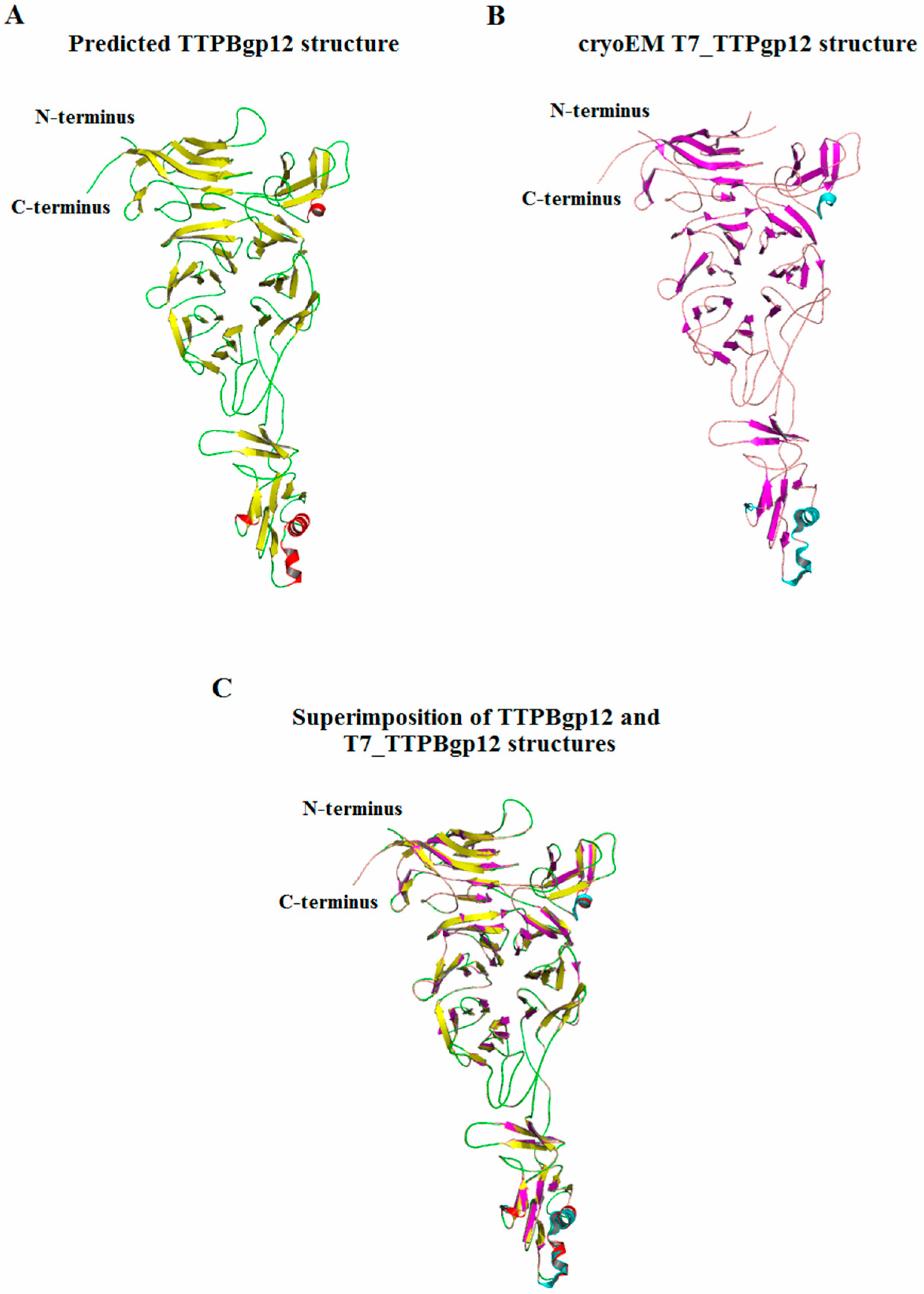
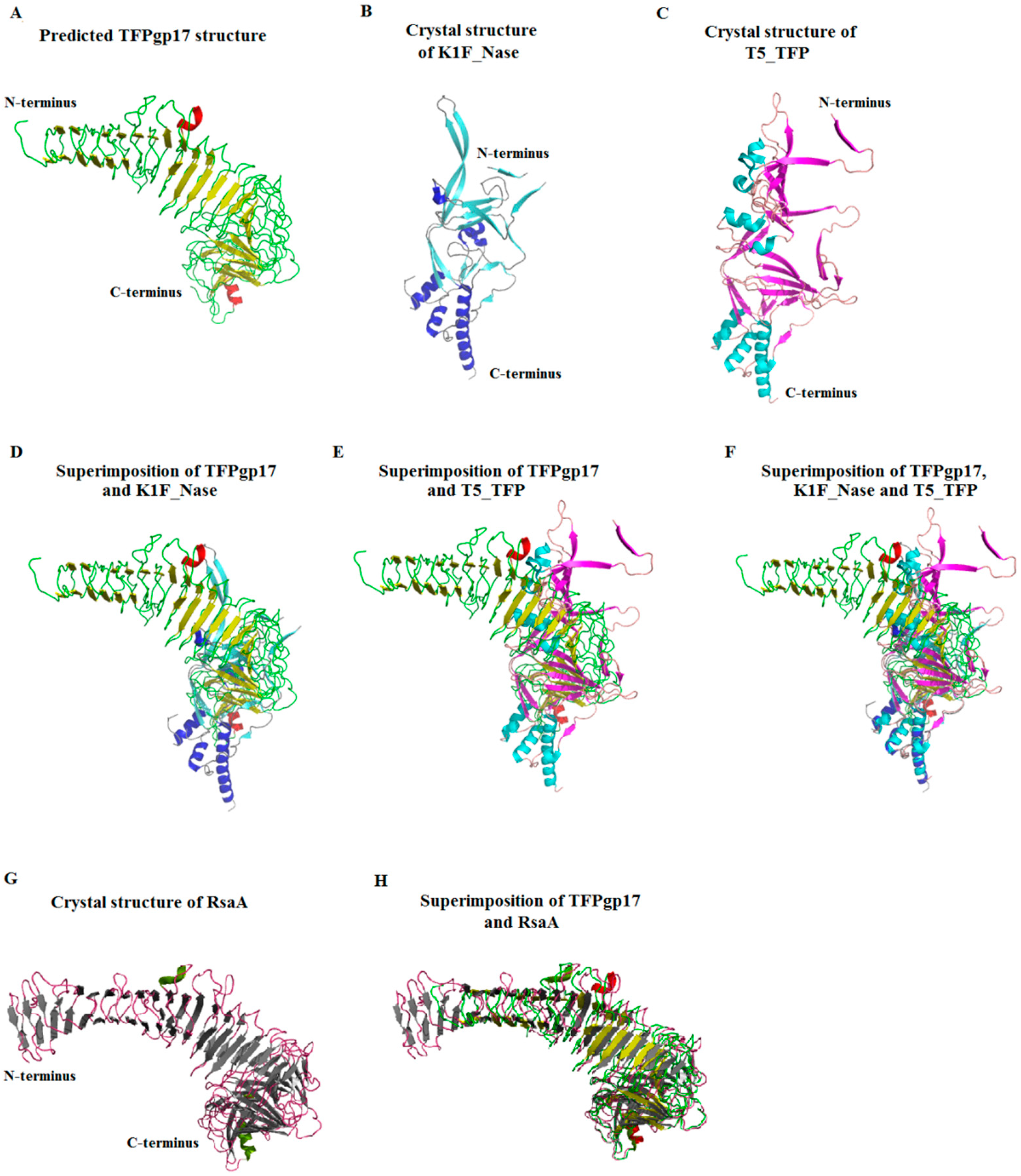
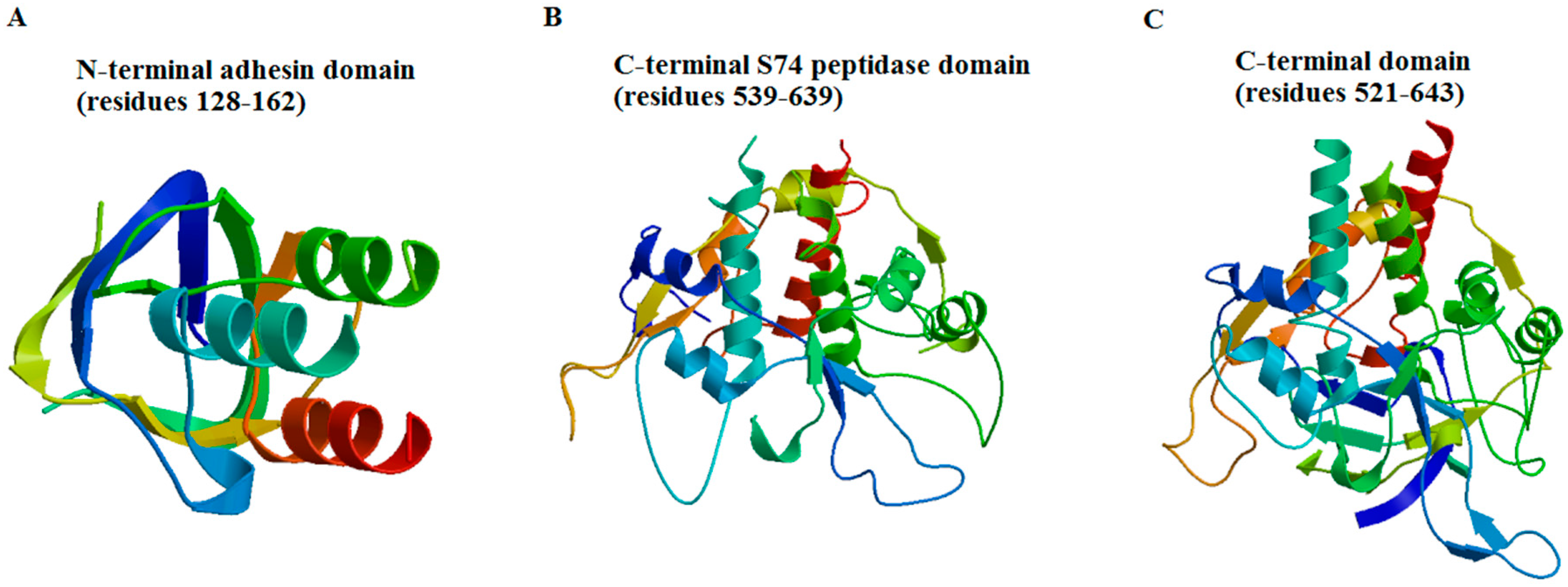


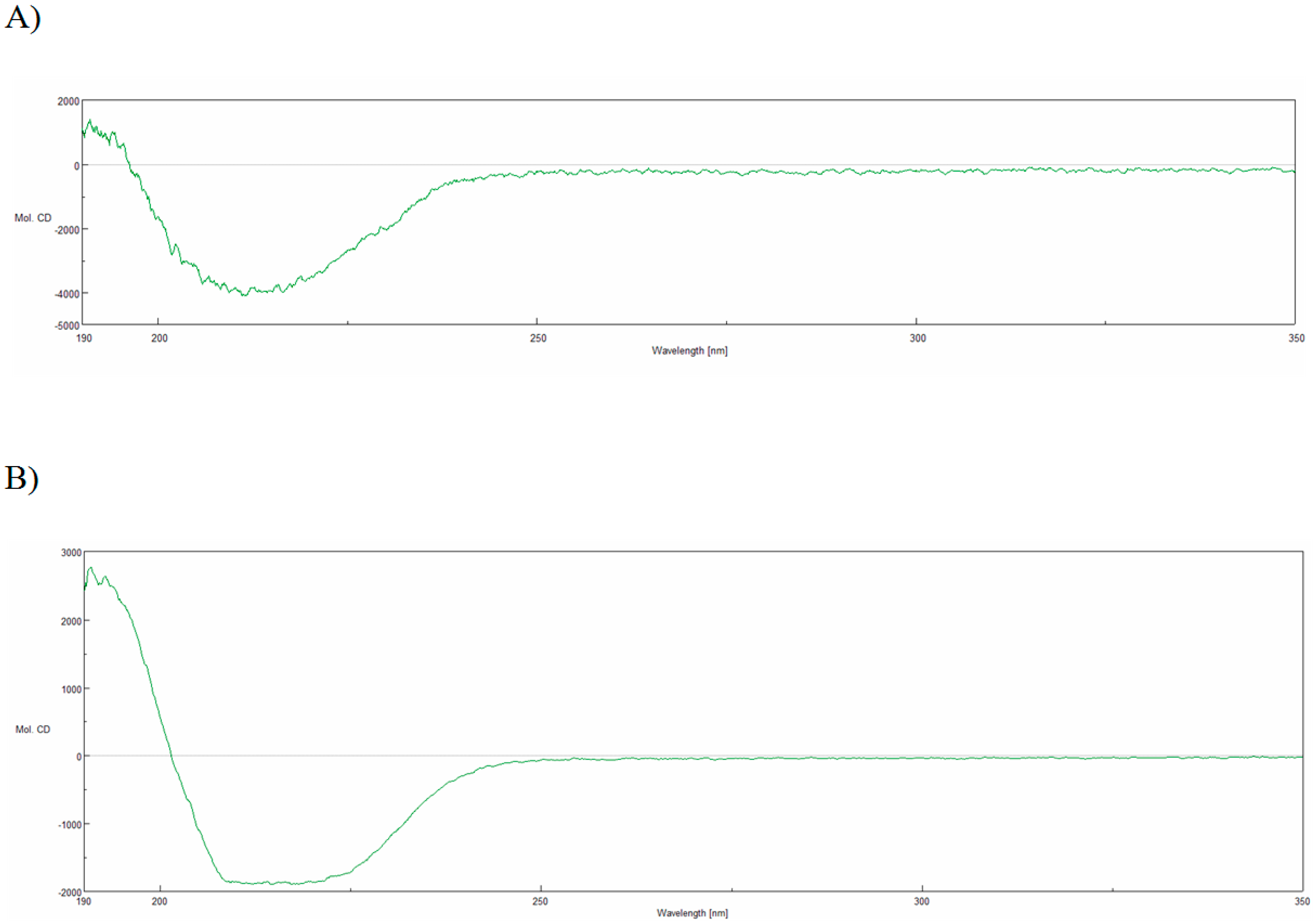
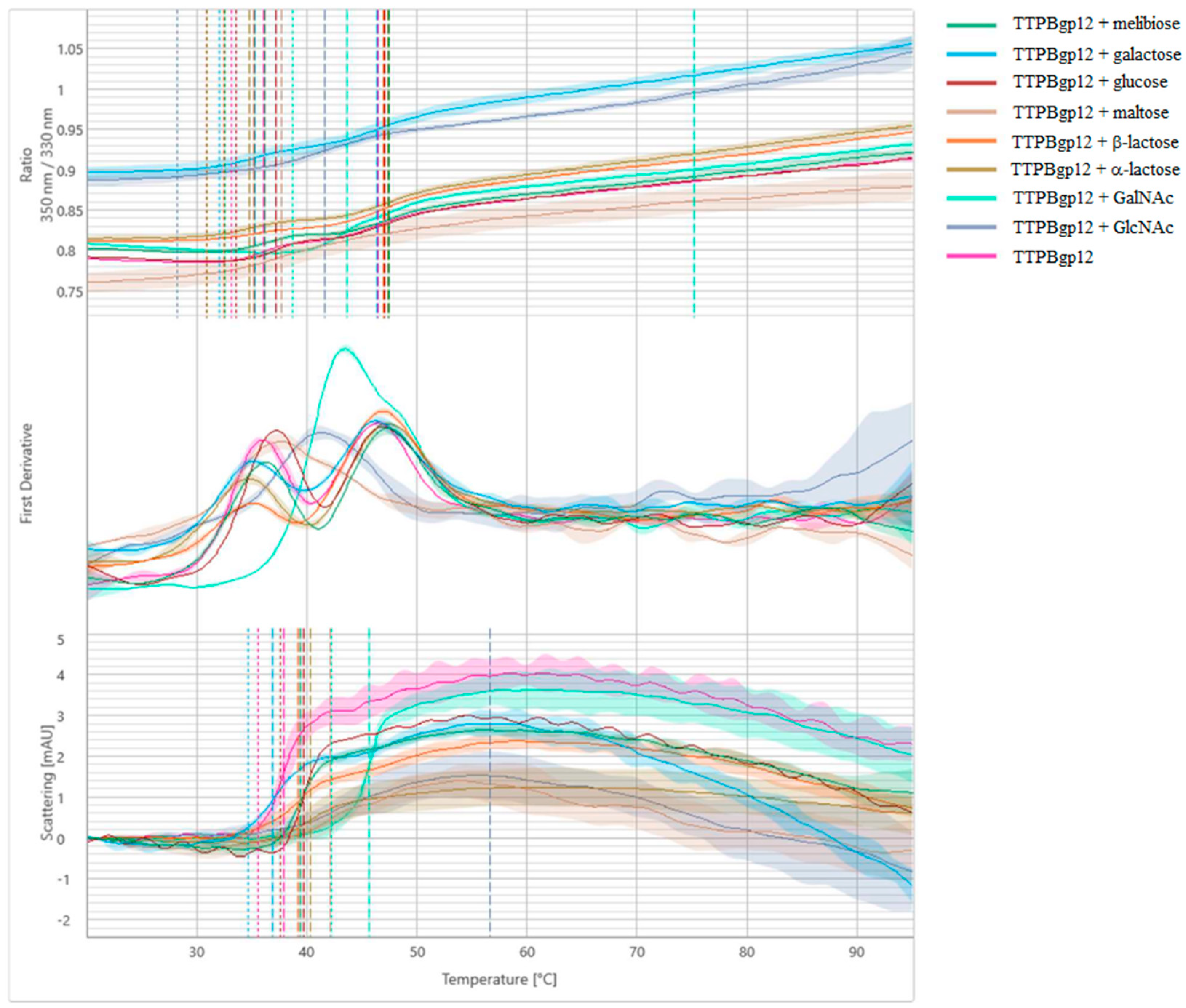
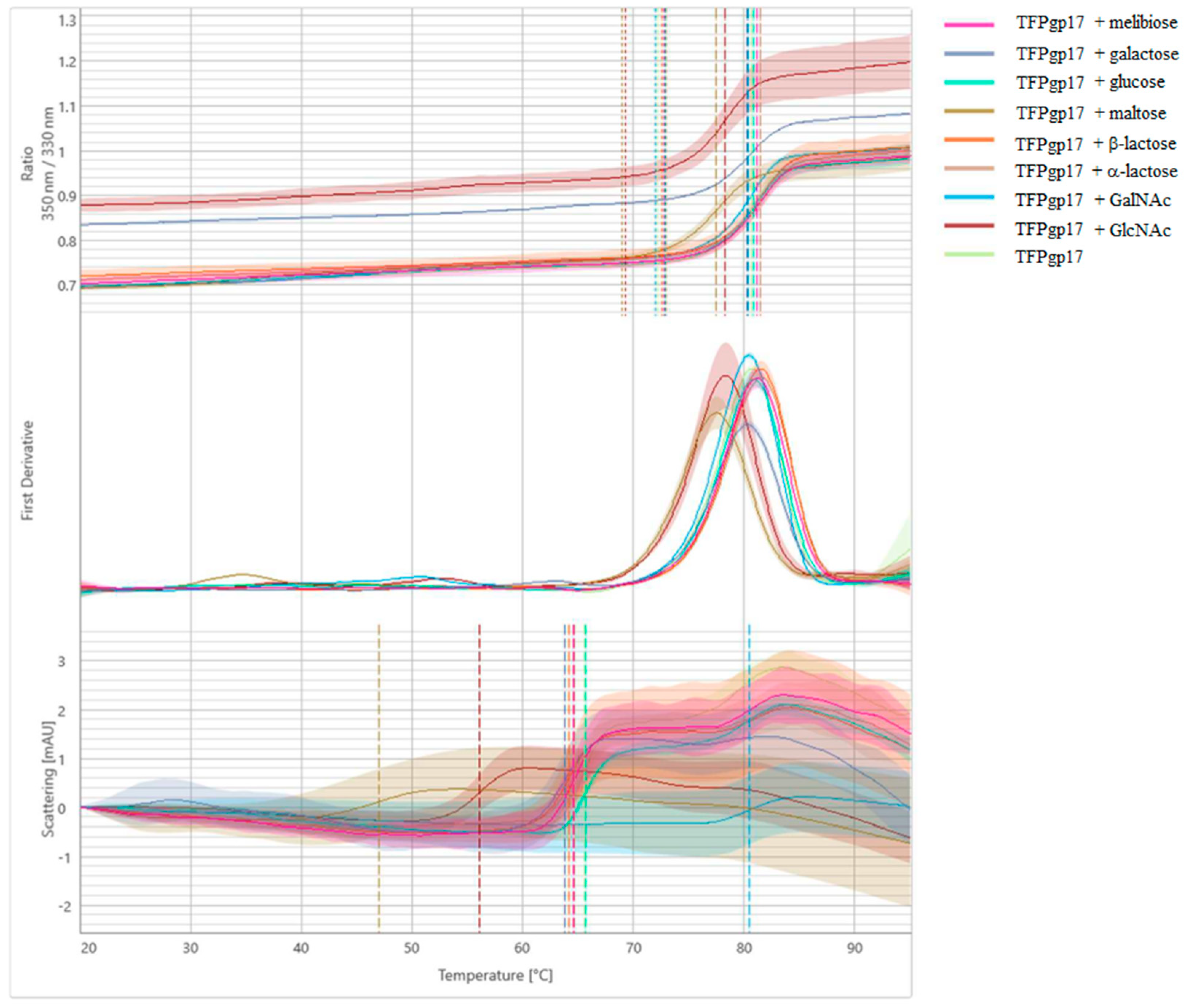

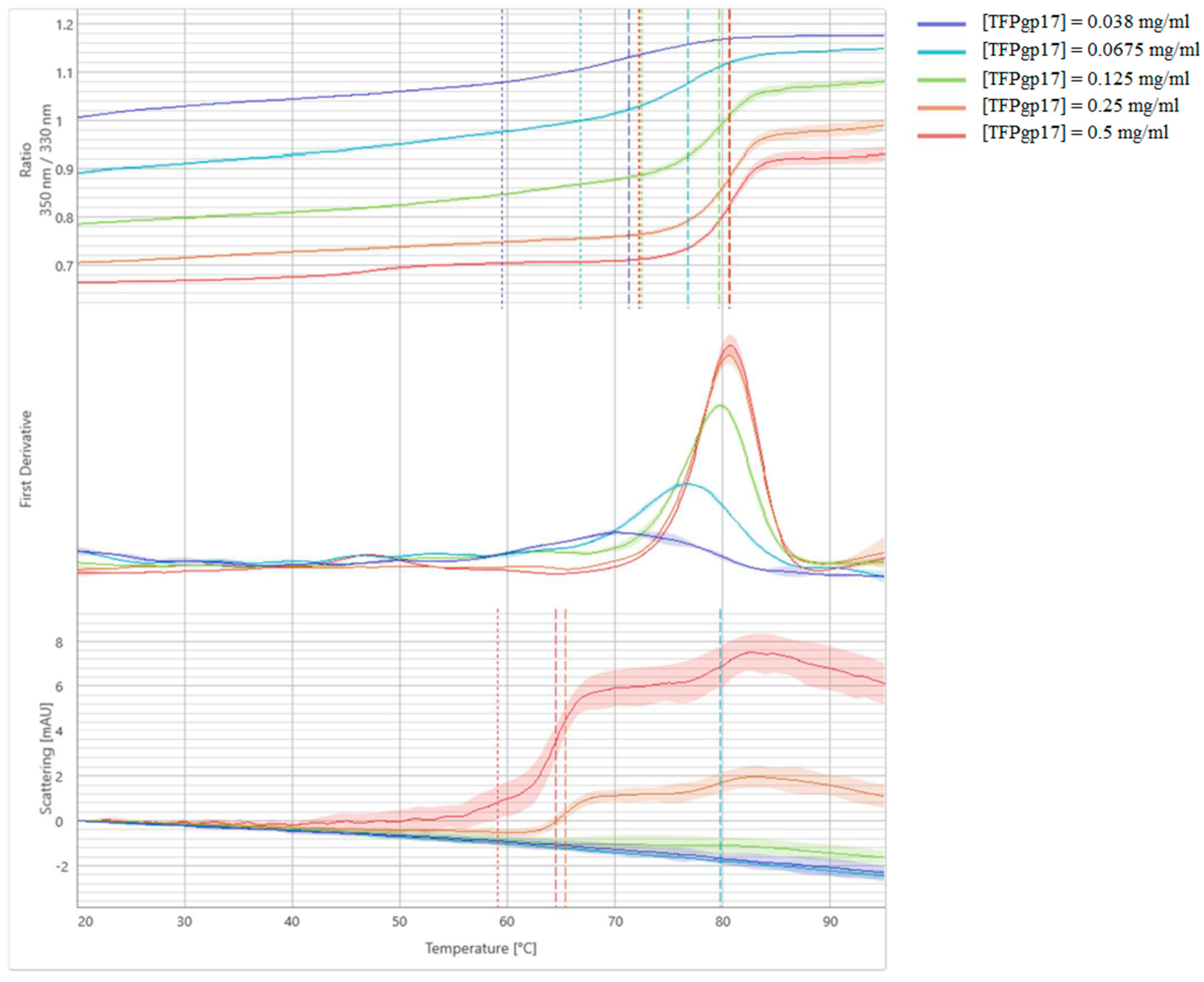
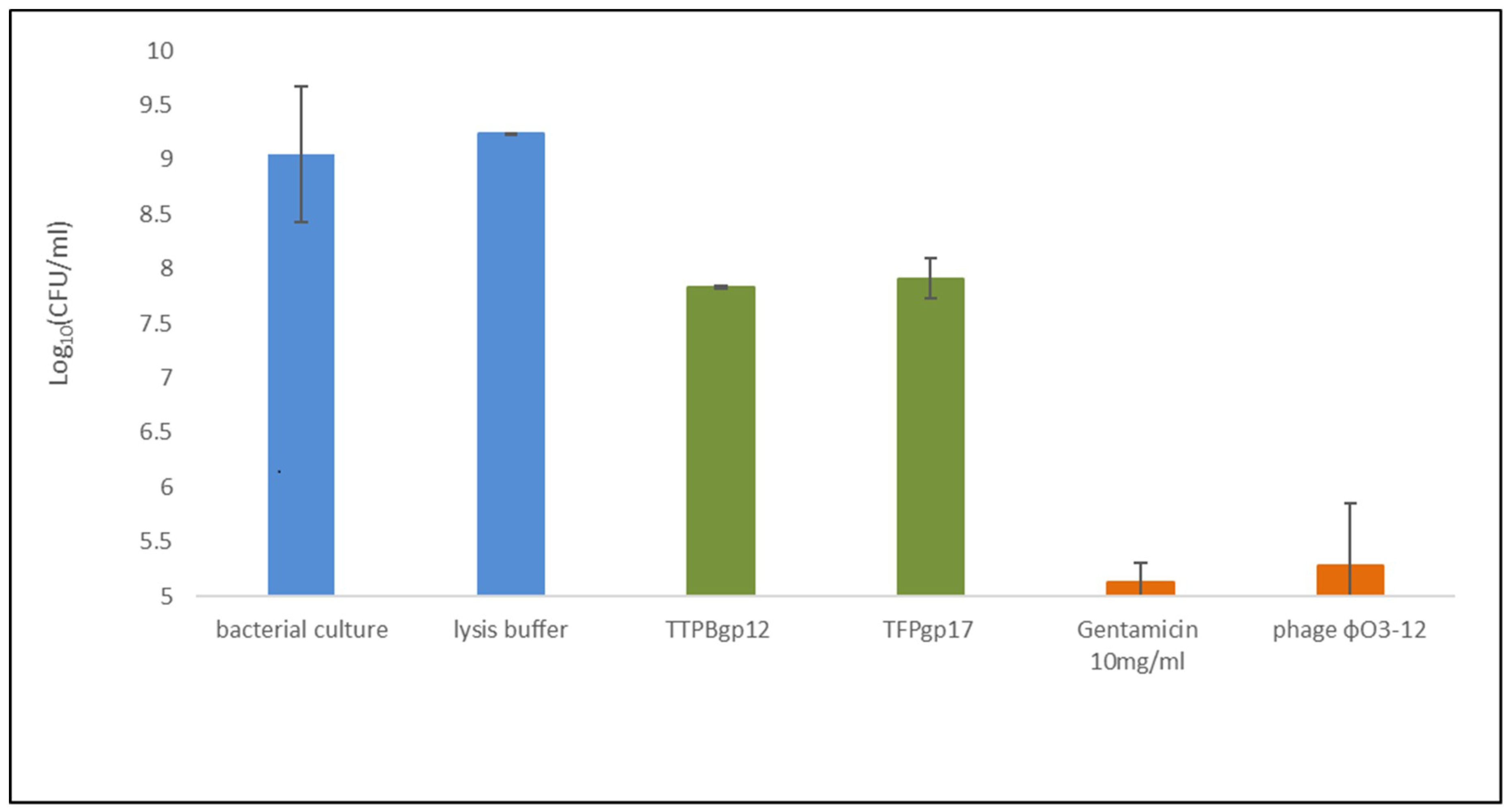
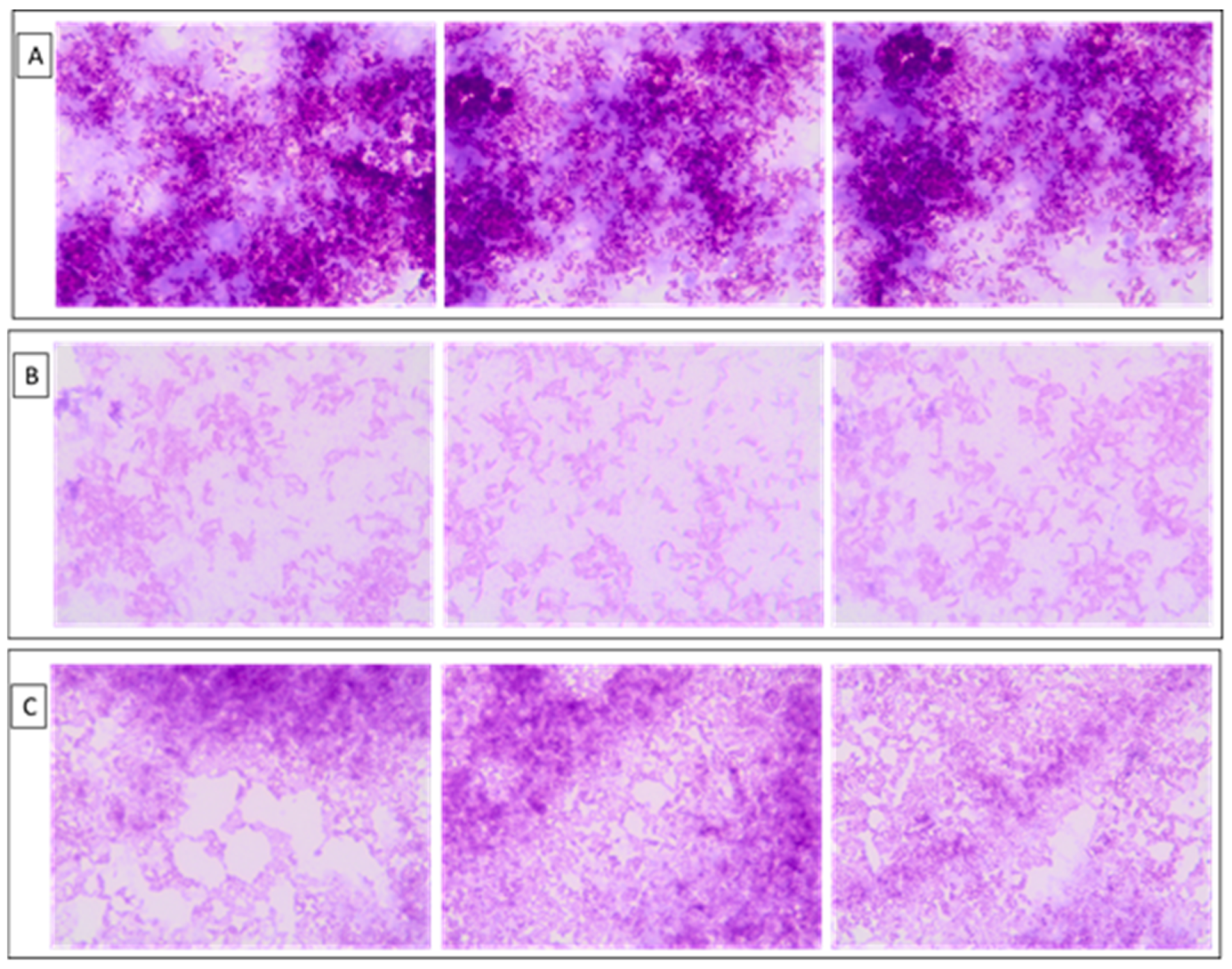
| Sample | Tm (°C) | |||
|---|---|---|---|---|
| Fluorescence Ratio 350 nm/330 nm | First Derivative | Scattering | ||
| #1 | #2 | |||
| TTPBgp12/melibiose | 36.20 | 47.45 | 32.51 | 39.43 |
| TTPBgp12/galactose | 35.30 | 46.40 | 32.02 | 36.93 |
| TTPBgp12/glucose | 37.21 | 46.98 | NA | 33.76 |
| TTPBgp12/maltose | 37.64 | NA | 30.85 | 42.11 |
| TTPBgp12/β-lactose | 35.13 | 46.96 | 32.46 | 39.19 |
| TTPBgp12/α-lactose | 34.74 | 47.42 | 30.99 | 40.31 |
| TTPBgp12/GalNAc | 43.65 | 75.19 | 38.73 | 45.65 |
| TTPBgp12/GlcNAc | 41.66 | NA | 28.23 | 56.61 |
| TTPBgp12 | 36.04 | 46.46 | 33.13 | 37.89 |
| TFPgp17/melibiose | 81.16 | NA | 72.83 | 64.64 |
| TFPgp17/galactose | 80.30 | NA | 72.88 | 63.78 |
| TFPgp17/glucose | 80.86 | NA | 72.89 | 65.71 |
| TFPgp17/maltose | 77.49 | NA | 69.03 | 46.99 |
| TFPgp17/β-lactose | 81.45 | NA | 72.57 | 64.19 |
| TFPgp17/α-lactose | 81.51 | NA | 73.01 | 64.66 |
| TFPgp17/GalNAc | 80.41 | NA | 71.96 | 80.45 |
| TFPgp17/GlcNAc | 78.29 | NA | 69.28 | 56.06 |
| TFPgp17 | 80.70 | NA | 72.15 | 65.55 |
| Sample | Tm (°C) | ||||
|---|---|---|---|---|---|
| Fluorescence Ratio 350 nm/330 nm | First Derivative | Scattering | |||
| Protein | Concentration (mg/mL) | #1 | #2 | ||
| TTPBgp12 | 0.0338 | NA | NA | NA | NA |
| 0.0675 | NA | NA | NA | NA | |
| 0.125 | 45.58 | NA | 28.50 | NA | |
| 0.25 | 35.87 | 46.13 | 33.03 | 37.68 | |
| 0.5 | 37.17 | 45.46 | 34.46 | 37.79 | |
| TFPgp17 | 0.0338 | 71.30 | NA | 59.45 | NA |
| 0.0675 | 76.80 | NA | 66.78 | NA | |
| 0.125 | 79.70 | NA | 72.49 | NA | |
| 0.25 | 80.54 | NA | 72.18 | 65.34 | |
| 0.5 | 80.67 | NA | 72.24 | 64.50 | |
© 2020 by the authors. Licensee MDPI, Basel, Switzerland. This article is an open access article distributed under the terms and conditions of the Creative Commons Attribution (CC BY) license (http://creativecommons.org/licenses/by/4.0/).
Share and Cite
Pyra, A.; Filik, K.; Szermer-Olearnik, B.; Czarny, A.; Brzozowska, E. New Insights on the Feature and Function of Tail Tubular Protein B and Tail Fiber Protein of the Lytic Bacteriophage φYeO3-12 Specific for Yersinia enterocolitica Serotype O:3. Molecules 2020, 25, 4392. https://doi.org/10.3390/molecules25194392
Pyra A, Filik K, Szermer-Olearnik B, Czarny A, Brzozowska E. New Insights on the Feature and Function of Tail Tubular Protein B and Tail Fiber Protein of the Lytic Bacteriophage φYeO3-12 Specific for Yersinia enterocolitica Serotype O:3. Molecules. 2020; 25(19):4392. https://doi.org/10.3390/molecules25194392
Chicago/Turabian StylePyra, Anna, Karolina Filik, Bożena Szermer-Olearnik, Anna Czarny, and Ewa Brzozowska. 2020. "New Insights on the Feature and Function of Tail Tubular Protein B and Tail Fiber Protein of the Lytic Bacteriophage φYeO3-12 Specific for Yersinia enterocolitica Serotype O:3" Molecules 25, no. 19: 4392. https://doi.org/10.3390/molecules25194392
APA StylePyra, A., Filik, K., Szermer-Olearnik, B., Czarny, A., & Brzozowska, E. (2020). New Insights on the Feature and Function of Tail Tubular Protein B and Tail Fiber Protein of the Lytic Bacteriophage φYeO3-12 Specific for Yersinia enterocolitica Serotype O:3. Molecules, 25(19), 4392. https://doi.org/10.3390/molecules25194392






